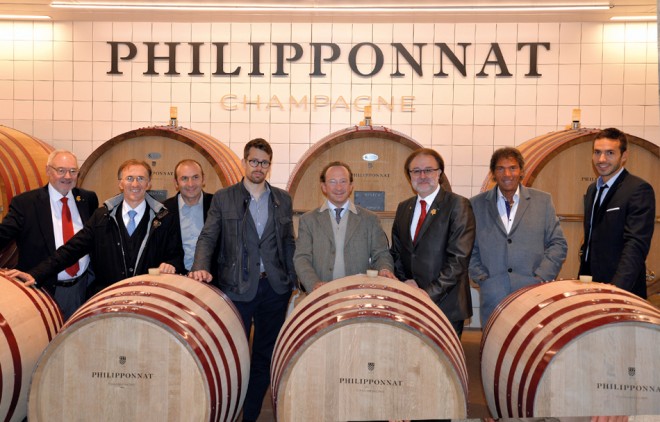The Philipponnat family has lived in Ay and Mareuil sur Ay, heart of the Champagne region, since the year 1522. It is the proud owner of a vineyard that includes the legendary Clos des Goisses, the largest enclosed parcel in Champagne. Made up of fourteen contiguous plots, and covering a total of 5.5 hectares, the Clos des Goisses is located on a steep hillside, facing south and overlooking the Marne river, just outside the village of Mareuil sur Ay. Its exceptional chalky terroir gives life to a cuvee by the same name, as well as a single vineyard cuvee called Les Cintres.

Following the great Champagne tasting organized by Sommeliers International in Reims, Charles Philipponnat, the current CEO , invited three World Best Sommeliers, Philippe Faure-Brac, winner in 1992, Paolo Basso, the 2013 Laureate, and Arvid Rosengren crowned in 2016, to visit the domain and taste a few special bottles.
Besides the Clos des Goisses, the Philipponnat domain owns another 12 hectares of vineyard. And it purchases the equivalent of fifty hectares of grapes to insure the production of a complete range of Champagnes, from the classic NVB (non vintage brut) to a prestige cuvee named “1522”.
The vast cellar houses barrels, vats and “demi-muids”, filled with reserve wines. Philipponnat maintains a “perpetual reserve” designed to bring complexity and texture to the assemblages of non vintage Champagnes. It resembles the aging process of Jerez wines, yet, Charles Philipponnat refuses to call it a “solera” system, since all the wines are mixed in a single barrel with no systematic topping off. However since this “perpetual reserve” was begun in 1945, it holds some wines that are over 70 years of age …
Vinifications are conducted in stainless steel tanks or in oak barrels. In the latter case Charles Philipponnat stops the malolactic fermentation to preserve the acidity of his wines. Maximum ripeness of the grapes at harvest insures that the wines have roundness as well. Dosages are low, and old vintages are kept “sur pointe” (an upside down vertical position), ready to be disgorged. “The Philipponnat philosophy, Charles says, is to produce wines that are aromatic and powerful, thanks to the Pinot Noir grape, but still display intense minerality.”
The tasting begins with a single vineyard, “Les Cintres”, from the 2006 vintage. It is a blend of 70% Pinot Noir and 30% Chardonnay, vinified in oak. The wine is impressive, fruity and aromatic. Everyone agrees that it would marry itself nicely with black mushrooms or truffles …
Next, Charles Philipponnat extracts from his “special reserve” a magnum still “sur pointe” that he disgorges by hand, on the spot, and serves to his guests challenging them to guess its vintage. The only information he puts forward is that it is a 100% Chardonnay from the Clos des Goisses. To Arvid Rosengren, the “low acidity level suggests a sunny year”. Everyone agrees. By consensus guests settle on 1976, which turns out to be correct. After initial iodine notes, the wine displays hints of pine cone resin, and star anise with a slight touch of oxydation.
At dinner, Charles Philipponnat opens a Clos des Goisses 2007 to be paired with a blue lobster and mango salad. “The wine has a wonderful balance with light oxydative notes on the nose but real freshness on the palate”, Arvid Rosengren says. Philippe Faure Brac stresses its “ripeness” and the contrast of a real “tension on the palate”. For Paolo Basso the wine “is refined and classy, at once creamy and savory, elegant with a long finish and strong personality.”
The turbot with a sherry cream sauce and small vegetables is paired with the Grand Blanc 1986, as well as the Reserve vintage 1982. The first one is a 100% Chardonnay, made exclusively from Grand Cru plots of the Côtes des Blancs area. The second is made from a Pinot Noir base.
For Paolo Basso the first wine shows off a nose of “caramel and maple syrup”. It is “evolved, yet delicate, with a touch of bitterness on its finish.” As to the Reserve vintage 1982, it has a nose of “white truffle and candied lemon”, and a “nice structure” but seems close to its “age limit”. Paolo’s favorite wine of the evening however turns out to be the Clos des Goisses 1996 that is served next. He finds it to be “still great”, with “hints of kumquat, spices, yeast and casein” as well as a “creamy and savory texture” on an “elegant and saline structure”.
As it turns out, the best rated wines of the evening all came from years ending in ‘6’, as 2006, 1996, 1986 and 1976. One more reason to wait impatiently for the … 2016!
Gérald Olivier
Gérald Olivier